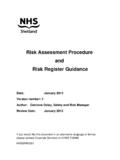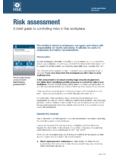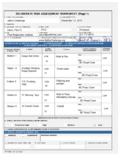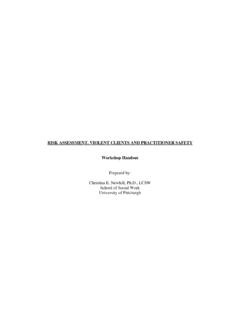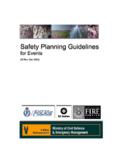Transcription of LINKING RISK ASSESSMENT OF MARINE …
1 Trbojevic1 MTS Conference 2001 LINKING RISK ASSESSMENT OF MARINE OPERATIONSTO safety MANAGEMENT IN PORTSDr. Vladimir M. TrbojevicEQE International LtdABS ConsultingABS House1 Frying Pan AlleyLondon E1 7 HRUnited KingdomTel: +44 20 7377 4577 Fax: +44 20 7377 4575 Email: approach for developing Integrated safety Management System (ISMS) formanaging navigation and other MARINE operations in ports is proposed. Themethodology requires that all risks are identified and evaluated, that suitable controlsare in place to manage these risks , and that the linkage between risk controls, operatingprocedures, harbour by-laws, and the management activities is explicitly methodology has been applied to a number of ports in the UK in compliance withthe Port MARINE safety Code requirement, [1].
2 An extension of the methodologytowards assessing focus and robustness of the ISMS is also discussed, and some ideasabout safety rating of ISMS are a consequence of the Sea Empress disaster in Milford Haven in 1988, the PortMarine safety Code (PMSC) was introduced in the UK IN March 2000, requiring allports to carry out risk ASSESSMENT of MARINE operations in order to implement the safetymanagement system, [1]. Deadline for implementation of the PMSC is the end of that ports are at the onset of safety regime utilised in other industries ( Report / Case regime), a suitable risk ASSESSMENT methodology has beenproposed which can easily be understood by all stakeholders in a port, [2].
3 This methodology has been inspired by increasingly obvious shortcomings in existingsafety technology, in lack of information transfer from hazard identification and riskassessment through to the safety management system. This means that a link betweenthe technical system description (risk model) and the demonstration of working of themanagement system in the context of major hazards control is often weak. This is notunusual because the methodologies for hazard analysis and risk ASSESSMENT , in general,do not deal with complex technical and organisational systems in a unified manner. Forexample, the quantitative risk ASSESSMENT (QRA) may account for operator error, Trbojevic2 MTS Conference 2001the quality of organisation and management by modifying human error failure rates,however to incorporate the probability of partial malfunction of the emergencysystem is hardly ever the proposed methodology, it is possible to include competency, personnel training,the establishment of operational constraints, supervision, communication andinformation exchange, etc.
4 Into the risk ESSENCE OF THE APPROACH The Integrated safety Management System (ISMS) is the final objective of this riskanalysis. It is called an integrated system because it explicitly links through riskcontrols, the hazard analysis of the technical system to the safety management of allprocesses in a port. Such an integrated system is shown graphically in Figure 1. Figure 1A Basis for ISMS ModelThreatConsequence11 DRAT hreatConsequenceZ22 AHLINKT hreatConsequence3 LINK3 THREATRECOVERYLINKBARRIERSMEASURESLINKOP ERATIONAL PROCESS MODELA ccidental EventThe main components of this ISMS are: The risk ASSESSMENT represented by a bow tie (diagram in Figure 1), that representsthe hazard and the barriers which if breached could lead to an accidental event(situation), which could escalate to unwanted consequences if the recovery measuresare not in place, The operational process model represented by activities and tasks port personnelhave to carry out on day to day basis, and The links between hazard barriers and recovery measures and tasks of Trbojevic3 MTS Conference 2001 Some of the activities (and tasks)
5 Are safety critical and they integrate the safetyobjectives, strategy and review at the senior management level, operating procedures ata technical support level, regulations, responsibilities related to planning and executing work at an operational level, and at task level, the responsibility for directmanagement of hazard barriers and recovery measures. Adding the managementobjectives for the activity, management accountability, performance indicators andperformance criteria, task responsibility and required competence, the basic blocks ofISMS are of the Process ModelThe process model is developed by mapping activities and tasks.
6 The activities wereclassified as related to management (A), operations (B) and support (C). The activitymodels, and in particular model for operational activities (B) were developed inconjunction with risk ASSESSMENT , in several iterations. Within each activity there isa set of tasks, and the starting point was to define an activity for each of the mainprocesses, VTS, pilotage, towage, docks/ports, pilot cutter, linesmen, etc. At laterstages, due to a large number of tasks, sub activities were defined for each mainactivity, as shown in Figure 2 Processes and ActivitiesForth Ports ProcessesActivitiesPre-arival notificationVessel schedulingArrival at Eastern limit and inital approachPilotageTug escortArrival at dock/port limitsApproach to dock entranceLock operationsBerthingDisconnection of tugsAt berth during cargo operationsPilot boarding and clearance for departureConnection of tugsUnberthingLock operationsSailing out of dock/port limitsOutward woyageDeparture of tugsDeparture of pilotOutward pasagePROVIDE NAVIGATION SERVICEV essel booking and inf ormation gatheringEstablish tidal restrictions f or vessel draught
7 And air clearanceSchedule vesselsMonitor vessels in the fairwayProvide assistance to pilots/mastersEnf orce bylaws, general and special directionsInterf ace with docks and terminalsManage anchorage areasActing in emergenciesEmergency operations of VTS without radar monitoringPrepare f or special eventsPROVIDE PILOTAGE SERVICEV essel booking and schedulingPlanning act of pilotageEmbarking and disembarkingAssessing standards on the piloted vesselCo-operating with the bridge team and functioning within itLiaising and communicating within the portEstablish tidal restrictions f or vessel draught and air clearanceTesting the vesselConduct of the vesselManoeuvring vessels in dif ferent locations and conditionsInteract with
8 TugsProvide berthing/unberthing adviceComply with bylaws and directionsPROVIDE TOWAGE SERVICETug booking and schedulingTug operationsTowage contingency operations PROVIDE DOCK/PORT MARINE SERVICEV essel inf ormation gatheringPre-arrival schedulingPlanning for arrivalOrganise dock services and lock allocationEstablish contact with vessel and provide navigation servicePrepare lock/dockSecure the vesselShif ting the vessel in the dockPrepare for departureLock operations for departureDeparture clearance and monitoringManage water level in the dockMonitor loading/unloading and mooringsEnf orcement of Port regulationsBunkeringDock f lood controlPROVIDE MARINE SERVICEP ilot boat operationsMooring boat Trbojevic4 MTS Conference 2001 Development of a Risk ModelThe risk analysis approach was described in [2] and is briefly summarised here.
9 In thisapproach it is assumed that each specific hazard can be represented by one or severalthreats that have the potential to lead to an incident or accidental event. Each accidentalevent may lead to unwanted consequences. In the example shown in Figure 3, topevent is berthing error (defined as a failure to berth the vessel safely, due toapproaching the berth with excess speed, or approaching the berth at an inappropriateangle, or giving an inappropriate command, or due to command execution failure, etc.).Consequences of this failure can be collision with the berth or another vessel, vesseldamage, 3 Berthing Error EventConsequenceDamage to berthConsequenceDamage to ManoeuvringLoc: Port of RosythEvent: Berthing errorThreatTug equipmentfailure - systemfailure - over-rulesthe Pilot - failure - to berth byuse of rope oranchorThreatApproaching berthat inappropriateangleThreatApproaching berthwith inappropriatespeed For each threat one or several barriers can be specified to prevent or minimise thelikelihood of hazard release.
10 In the example in Figure 4, barriers to the threat of approaching berth with inappropriate speed are Competent Pilot and CompetentMaster . For any barrier there may be internal or external factors which influence itseffectiveness, for example, a competent pilot may have failed to familiarise with thevessel manoeuvrability, say due to commercial pressure, or he may have under-estimated weather effects due to lack of operational criteria in the port. These barrierfailure modes are be modelled as escalation factors each of which can be controlledby escalation factor control , Figure 4. The escalation factor controls can beenvisaged as secondary barriers; for example, if the master has not familiarised Trbojevic5 MTS Conference 2001 Figure 4 Barriers and Recovery Measures ManoeuvringLoc:Port of RosythEvent: Berthing errorThreatApproaching berthat inappropriateangleThreatFailure to berth byuse of rope oranchorMaster identifies and rectifieserrorP / PilotCHM / berthwith inappropriatespeedPilot takes additional safetym




